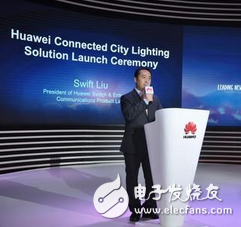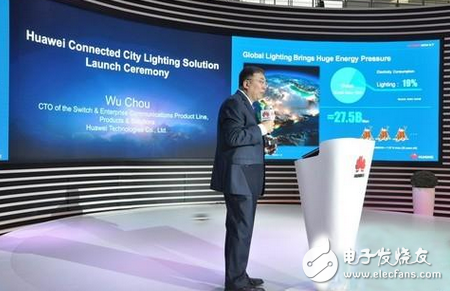On March 15, 2016, Huawei unveiled the industry's first multi-level intelligent control lighting IoT solution at CeBIT 2016 (Hanover Consumer Electronics, Information and Communication Expo), the world's largest ICT technology exhibition. The scheme integrates the urban lighting street lights into the IoT network and visually manages them based on GIS. The manager can clearly understand the status information of each street and each street lamp; by applying flexible lighting strategies, each street lamp can be used. The switch state and illumination brightness are precisely controlled to achieve on-demand illumination with energy efficiency up to 80%.

Speech by Liu Shaowei, President of Huawei Switch and Enterprise Communication Product Line
According to The Climate Group, the number of street lights in the world is about 304 million, and will reach 352 million in 2025. Streetlights everywhere in the city, while bringing convenience to people's lives, the huge energy consumption and high management costs of the city also make the city managers painstaking. In London, for example, street lighting consumes more than 56 million kilowatt-hours per year (according to The Climate Group, the number of street lights in London is about 35,000 baht. Based on 400W high-pressure sodium lamps), huge energy costs are added. Manual inspection and management and maintenance costs are a big expense for city managers. Huawei's lighting IoT solution will solve the problem for urban managers.

Huawei switch and enterprise communication product line CTO Zhou Wei released solutions
Lighting strategy "combination boxing" comes together to ensure high efficiency and energy saving
A street light controller is installed for each street light to control the switch and dimming. Different from the industry's use of streetlight access methods such as Wi-Fi, Huawei uses IPv6-based 6LoWPAN technology, which has low power consumption, self-discovery, self-organizing network, and can be self-healing quickly, and can be better and better. Sensors and other smart devices interact. In the control of street lamps, the lighting strategy has a set of "combination boxing", which can be calculated based on the local latitude and longitude. The lighting duration of different seasons, different months and even every day can be dynamically adjusted. It can also be combined with the built-in brightness sensor. Third-party traffic, human flow sensors, etc. are linked, or intelligently adjusted according to actual weather and environmental conditions. For example, when the traffic flow is scarce late at night, the brightness of the street lights is turned down, and the lights are turned on at intervals; in the rainy weather with poor lighting conditions, the lights are turned on according to the brightness perception. The Huawei solution is based on LED street lights and uses a combination of lighting strategies. Compared with traditional street lamps such as high-pressure sodium lamps, the energy-saving efficiency is as high as 80%.
Visual management, street lamp online inspection, failure failure prophet
The solution uses GIS-based visual management. One person can manage thousands of street lights in multiple blocks. The number of street lights, street lights, installation location, installation time and other information in each block is clear at a glance. When the street light fails, the system will automatically alarm and send a message to notify the maintenance personnel to repair it in time. The system can also manage the life cycle of street lamps, anticipate possible failures in advance, and achieve forward-looking maintenance. This management mode has changed the situation of relying on manual regular street inspections in the past, which not only saves labor costs but also improves management efficiency.
Multi-level intelligent control, multiple levels of protection, multiple layers of reliability
Traditional street lights generally use centralized control and cannot accurately control individual street lights. When the control network is faulty, it is not uncommon for many street lamps to appear "competing with the sun" during the day, resulting in waste of energy. Multi-level intelligent control is the biggest feature of Huawei's solution. It includes two levels of local intelligent control and one-level network intelligent control. Both the Agile IoT Gateway and the Street Light Controller can be equipped with lightweight agile planning components to support the localization of lighting strategies to form a two-level local intelligent decision-making mechanism. When the uplink network of the agile gateway fails, it can quickly switch to the local control strategy; when the 6LoWPAN sensor network fails, the streetlight controller can work completely offline and operate independently. Multi-level intelligent control minimizes the dependence of street lights on the control network.
Multi-level open, a total of painted smart city blueprint
Another major feature of the Huawei solution is the adoption of a full-level open architecture. The underlying control chip can be developed based on the open source lightweight operating system Liteos. Devices from different vendors can interact better based on unified standards; agile gateways support virtualization architecture, partners can develop and install customized applications; agile controllers It provides a standard northbound interface for third-party application systems, which facilitates the expansion of various service components, and achieves all-round linkage with intelligent transportation, environmental monitoring, and urban governance, providing first-hand big data for municipal management.

Huawei and partner ESL (Enika Smart Light as) jointly released lighting Internet of Things solutions
“Since Huawei released the Agile IoT solution in May 2015, it has gradually spawned many industry solutions such as power Internet of Things, intelligent buildings, and smart animal husbandry. Lighting Internet of Things is an agile IoT solution in the field of urban lighting. A successful practice. This program is an important part of the construction of smart cities. With the advancement of smart city construction, more sensory facilities can be added on the basis of lighting Internet of Things, environmental monitoring, traffic monitoring, intelligent charging. Various objects such as piles and smart trash cans are included in the perception network to provide basic data support for smart cities and expand more intelligent services.†Zhou Wei, CTO of Huawei switches and enterprise communication product line, said.
Can you boost your WiFi signal with outdoor 4G CPE?
When you travel or go to some remote areas, you may be annoyed by poor reception. Is there any way to get a strong WiFi router signal outdoors in a 4G LTE network? Very good, outdoor 4G CPE router would be a good choice!
What is an outdoor 4G CPE router?
An outdoor 4G CPE router differs from a Wifi-only router in that it needs to be connected to a fiber optic network. The 4G CPE WiFi router can pick up the carrier's 4G LTE network signal and convert it into broadband and Wi-Fi. Just plug in your SIM card with your data plan and enjoy a stable and reliable WiFi signal with family and friends. This Outdoor CPE can be used in harsh environments. If you install your router outside or near a window in an area with a weak 4G signal, your device can receive a better 4G signal.
Second, what are the characteristics of outdoor 4G CPE router?
1. Better network for ODU and IDU
4G CPE outdoor routers include an outdoor unit (ODU) and an indoor unit (IDU). Help your device receive the best outdoor cellular signal through the ODU, and connect to the indoor WiFi router through the network cable to experience better network speed. As shown in the figure below, an outdoor LTE CPE (ODU) is installed outdoors and connected to an indoor Wi-Fi router (IDU) via a network cable. The entire 4G device is powered by POE. This data will be transmitted over the same Ethernet cable, eliminating the need to connect the ODU to a power outlet.
2. High-speed multi-user available
The outdoor 4G CPE features a built-in 4G LTE modem and a 5dBi high-gain antenna. LTE CAT4, download speeds up to 150Mbps, WiFi speeds up to 300Mbps, can connect 32 users at the same time. The high-gain antenna of the outdoor 4G CPE router enables it to have higher power and stronger signal transmission and reception capabilities than mobile phones. Therefore, the CPE router can receive the signal. If your phone can't receive a signal in some areas. Sometimes you also use your phone as a hotspot to share Internet access with your friends, right? Similarly, this 4G LTE CPE router allows 32 users to connect to WiFi at the same time, allowing more users to connect and receive a better signal than a phone sharing hotspot. In addition, the IDU has four Lan ports and can be connected to the device through network cables, which is also a backup mode of the Internet.
3. Excellent outdoor performance and design
On the one hand, outdoor LTE CPE is waterproof, UV resistant and corrosion resistant. It can be used at -20℃~60℃ operating temperature. Therefore, it is ideal for outdoor deployment. On the other hand, there are a variety of installation methods. CPE can be mounted on Windows or walls by mounting brackets. It is also possible to attach it to the antenna mast. In addition, the signal strength is displayed through the LED indicator to facilitate users to find the best location to get a better 4G signal.
4. Support different frequency bands
Outdoor 4G CPE supports a variety of frequency bands, including LTE-FDD, LTE-TDD, 3G WCDMA, and 2G GSM network bands. Meet the needs of different frequency bands in different regions and make full use of network resources.
5. Convenient management of CPE
Start the Web browser to log in to the Web management page. You can configure and manage the CPE easily. The web management system supports Linux. Provides functions such as WebUI management, Telnet, SSH terminal system status monitoring, NTP client, synchronization between devices and the system clock network, and configuration file import and export.
6. Applicable to various application scenarios
CPE is designed to provide ISP or operator with 4G LTE outdoor wifi router to facilitate network connection, whether at home, or in enterprises and remote areas, to bring users a wonderful network experience.
All in all, an outdoor 4G CPE router is an excellent choice for connecting to the Internet in remote areas and places where the signal is weak, the wired network is unreliable, or there is a lack of reliable WiFi. It's worth deploying outdoor CPE in rural, coastal, boat, caravan, campsite and remote areas to enjoy the best network speeds and outdoor activities! It can even reduce complex cabling deployments for home networks without the need to install a wired fiber network.
4G Outdoor Cpe,4G Lte Outdoor Cpe Router,4G Lte Outdoor Cpe,Outdoor 4G Lte Cpe Router
Shenzhen MovingComm Technology Co., Ltd. , https://www.movingcommiot.com